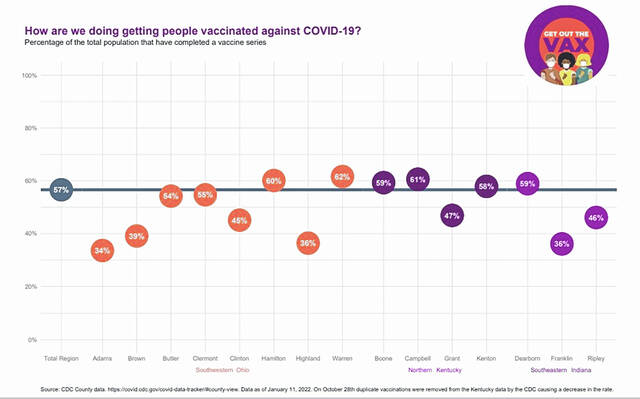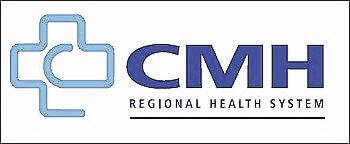


WILMINGTON — As COVID-19 case numbers and hospitalizations reach their highest levels ever, Clinton Memorial Hospital is at capacity, again. Our beds are full with both patients who are being treated for COVID-19 and those who have other acute and chronic issues that need immediate medical attention.
The region’s hospitals are facing emergency conditions due to the high rate of COVID-19 hospitalizations mixed with other serious conditions. Nearly all beds are full.
The Ohio Department of Health data shows COVID-19 deaths have started to creep back up and are now at times back over 100 a day, this is like two-plus bus crashes every day with no survivors.
It is important to note that our patient volumes continue to increase while available staff continue to decrease. “Nursing staff shortages are impacting healthcare like never before,” said Dr. Brian Santin, CMH’s Chief Medical Officer.
The rapid influx of patients has affected the number of patients each nurse has to work with and the quality of care they’re able to provide.
Influx limits care
“When nurse-to-patient ratios go up, we are limited in the care that we are able to provide, so things, like baths and linen changes, and some of the nice things that we like to do for our patients, we cannot do,” Santin said.
“Every day the staff and physicians of CMH are struggling with high volumes of patients, but the resiliency, dedication, and commitment to providing nothing less than high quality care to our community remains unwavering.”
Clinton County Commissioner Kerry Steed added about the CMH staff, “Their exemplary efforts during this pandemic continue to exceed the needs of those that are sick.”
Unprecedented
CMH’s Emergency Department is also seeing unprecedented volumes of patients seeking care — both emergent and non-emergent. This is not unique to CMH, at every hospital in the region; patients are waiting longer for care in Emergency Departments (ED) and in hospitals.
“When EDs are inundated with COVID-19 patients, it means lower acuity patients, those with COVID or other illnesses or injury are having to wait longer for care,” said Dr. David Cohen, Emergency Department, Medical Director.
In the ED, truly emergent patients are always cared for before others. This also impacts patients being admitted to the hospital from the ED, you might wait in the ED longer than usual before going to an inpatient bed. This wait time could be several hours to several days.
Also, if you need to be transferred to another hospital for specialized care, you could need to remain at CMH for hours to days or longer as all other hospitals are experiencing similar very high capacity.
What you can do
There are some simple things we can do to help reduce the local hospitalizations and ease the pressure on healthcare workers:
• Get vaccinated. And get your booster. Vaccines are administered weekly by CCHD in the Community Room at the Clinton County Annex Building on Tuesdays from 8:30-11:30 a.m., or Wednesdays from 1-4 p.m.
• Practice social distancing.
• Wear a quality mask even if you’re vaccinated. A three ply surgical mask, KN95, and N95 are best. If you have to wear a cloth mask, they should be several layers and well-fitting.
• Clean your hands frequently with soap and water for at least 20 seconds.
• Stay home from work/school/activities if you are feeling ill.
• Test to prevent spread. If you have symptoms, get tested at your pharmacy, urgent care or locally hosted testing sites (not the emergency room) found at https://healthcollab.org/testandprotect/ or https://coronavirus.ohio.gov/wps/portal/gov/covid-19/dashboards/other-resources/testing-ch-centers .
The Emergency Department does not conduct routine COVID-19 testing for asymptomatic individuals or do post exposure testing.
• If your illness or injury is not emergent, consider alternative places for low acuity care.
• If you are not feeling well and experiencing mild symptoms, stay home. “Many of the symptoms of the Omicron variant are mocking those of a common cold and/or sinus infection,” said Dr. John Hollon.
• If you have symptoms call your primary care provider for guidance on testing and recommendations for managing those symptoms. If you have serious symptoms or are having trouble breathing, come to the Emergency Department.
• If you do test positive for covid-19 follow up with your provider to discuss if you qualify for monoclonal antibody treatment or other treatment options.
Need your help
CMH prides itself on providing great care to our community. We stand ready to serve your healthcare needs — but we need your help.
Please do your part to protect yourself, your family members and your fellow community members by practicing social distancing, avoiding large gatherings, washing your hands regularly, and wearing a mask or face covering while in public.
We are at a critical point in this pandemic, and it will take all of us working together in the fight against COVID-19.
Please, do not delay essential and especially emergency care. It is safe to come to the hospital.




